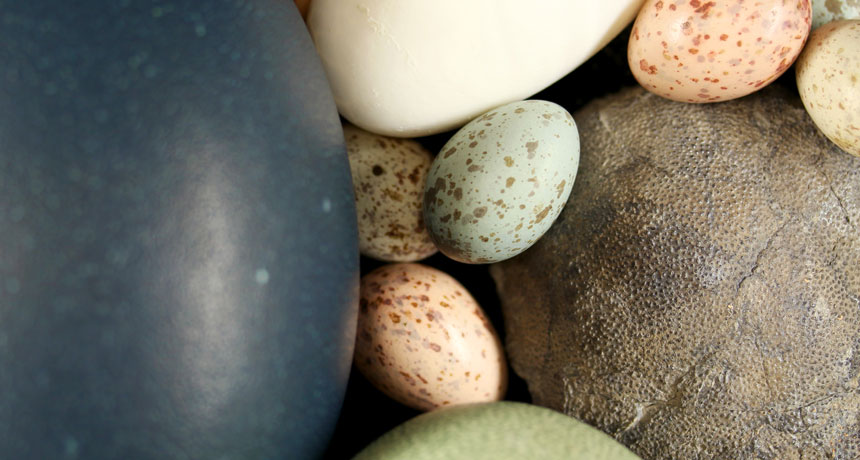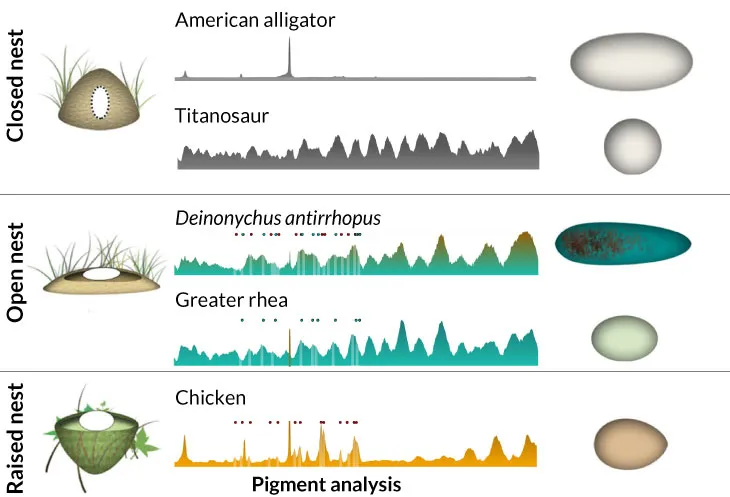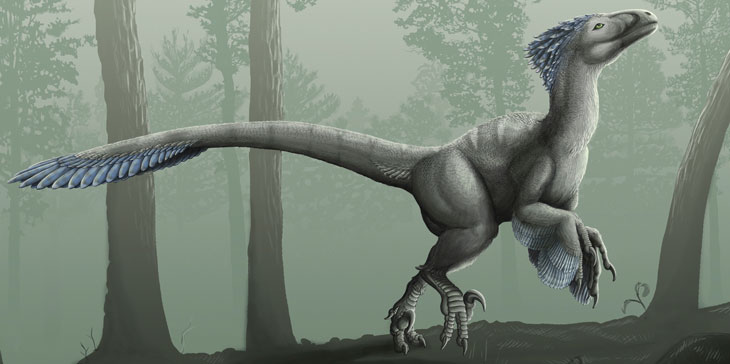Eggs evolved color and speckles only once — during the age of dinosaurs
Analysis of pigmentation in the eggs of modern birds and nonavian dinosaurs suggests similarities

MOTTLED CREW Colorful eggshells were a trait shared not only by ancient and modern birds, but also by their theropod dinosaur ancestors (as seen in the large fossilized egg at right).
J. Wiemann/Yale Univ.
- More than 2 years ago
The colorful, speckled eggs of modern birds are an innovation inherited from their nonavian dinosaur ancestors.
A new analysis of the pigmentation in modern and fossilized eggshells suggests that eggs evolved to be colorful only once — in modern birds’ dinosaur ancestors, a team of vertebrate paleontologists report online October 31 in Nature. Color patterns found in the eggshells of theropod dinosaurs, a lineage that includes Tyrannosaurus rex and smaller winged dinosaurs such as Microraptor, were very similar to those of modern birds, says Jasmina Wiemann of Yale University.
Scientists once thought only birds produced colorful eggshells, says coauthor Mark Norell of the American Museum of Natural History in New York City. But a growing body of literature suggests that many traits once thought to be unique to birds — feathers, flight, brain organization and adaptive metabolisms needed for flight — evolved long before modern birds did (SN: 4/14/18, p. 9; SN: 5/26/18, p. 8; SN Online: 10/19/18). “It’s kind of blurring the line between what’s a bird and what’s a [nonavian] dinosaur,” Norell says.
Bird eggs get their color from two pigments: a red-brown pigment called protoporphyrin, which creates speckles and is found only in an eggshell’s soft, outer cuticle layer; and a blue-green pigment called biliverdin, found in the deeper, crunchier part of the shell. In 2015, Wiemann and her colleagues reported that fossilized eggshells of Heyuannia huangi, a short-beaked, crested dinosaur that lived about 70 million years ago, contained traces of both pigments (SN: 6/27/15, p. 14).
Eggstravaganza
Researchers found no traces of pigment in eggshells belonging to a long-necked titanosaurid dinosaur, or in the eggs of a modern American alligator, both of which have buried nests. But traces of blue-green or red-brown pigments — or both — were found in the eggshells of theropod dinosaurs such as Deinonychus antirrhopus as well as such modern birds as the flightless greater rhea and the chicken, all of which have at least partially open nests.
In a pigment analysis, peaks correspond to the presence of particular molecules in the eggshell. The shell contains the pigment only if all the molecules in that pigment are present (pattern of dots), like a fingerprint.

That suggests a much older evolutionary origin of the pigments than thought. But Wiemann wanted to know how common eggshell coloration might have been among nonavian dinosaurs and their relatives. So her team, which included Tzu-Ruei Yang of the University of Bonn in Germany, used a technique called Raman spectroscopy to scan for traces of the two pigments in the eggshells of 19 species on the extended family tree. Those species ranged from the American alligator to modern birds such as the chicken and emu to nonavian dinosaurs.
The technique uses a laser beam to scatter light off molecules in the shells, with the pigments producing peaks at characteristic wavelengths — like a fingerprint match. The researchers also analyzed the eggshells of a variety of nonavian dinosaurs, including more than half a dozen different theropod species, the herbivorous crested ornithischian Maiasaura peeblesorum and a long-necked titanosaur.
Only the theropods had colored shells that contained one or both pigments, the team found. Pigment patterns, or where the color was distributed, were nearly identical between the eggs of modern birds and nonavian theropod dinosaurs. That suggests that coloration evolved only once, rather than multiple times among birds, the team reports.

“We can infer a lot of ecology and paleobiology based on color, such as nesting biology and behaviors,” Wiemann says. For example, the team found that the nonavian dinosaurs with colorful eggs also had open, or partially open, nests, where the dinosaurs sat directly on the eggs, as modern birds do (SN: 6/9/18, p. 32). The dinosaurs with colorless eggs, including the ornithischians and the sauropods, buried their eggs, like modern crocodiles and turtles do.
There are several possible reasons for an association between colorful eggs and open nests, including the need for camouflage. “In modern birds, the overall color tone of the eggs aims to mimic the color tone of the nesting environment,” Wiemann says. Colorful shells could have helped regulate incubating egg temperatures. And unique pigment patterns on the shells may have helped animals recognize their own eggs. “It suggests that the ecology is much more complex than we thought.”
The discovery that pigmented eggshells evolved in nonavian theropod dinosaurs “will change the way we think about dinosaur nesting and incubation behavior,” says Mary Caswell Stoddard, a vertebrate paleontologist at Princeton University who was not involved in the study. Stoddard notes that the find raises interesting questions about the diversity in ancient eggs that “behavioral ecologists and paleontologists will be asking in the years to come.”







